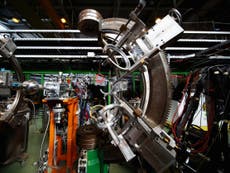The discovery of a mystery particle at Cern could totally shake up our understanding of science
If this particle really exists, then it is not just outside the standard model but outside it in a way that nobody anticipated. Just as Newtonian gravity gave way to Einstein’s general relativity, the standard model will be superseded

There was a huge amount of excitement when the Higgs boson was first spotted back in 2012 – a discovery that bagged the Nobel Prize for Physics in 2013. The particle completed the so-called standard model, our current best theory of understanding nature at the level of particles.
Now scientists at the Large Hadron Collider (LHC) at Cern think they may have seen another particle, detected as a peak at a certain energy in the data. Although the finding is yet to be confirmed. Again there’s a lot of excitement among particle physicists, but this time it is mixed with a sense of anxiety. Unlike the Higgs particle, which confirmed our understanding of physical reality, this new particle seems to threaten it.
The new result – consisting of a mysterious bump in the data at 28 GeV (a unit of energy) – has been published as a preprint on ArXiv. It is not yet in a peer-reviewed journal – but that’s not a big issue. The LHC collaborations have very tight internal review procedures, and we can be confident that the authors have done the sums correctly when they report a “4.2 standard deviation significance”. That means that the probability of getting a peak this big by chance – created by random noise in the data rather than a real particle – is only 0.0013 per cent. That’s tiny – 13 in a million. So it seems like it must be a real event rather than random noise – but nobody’s opening the champagne yet.
Many LHC experiments, which smash beams of protons (particles in the atomic nucleus) together, find evidence for new and exotic particles by looking for an unusual build up of known particles, such as photons (particles of light) or electrons. That’s because heavy and “invisible” particles such as the Higgs are often unstable and tend to fall apart (decay) into lighter particles that are easier to detect. We can therefore look for these particles in experimental data to work out whether they are the result of a heavier particle decay. The LHC has found many new particles by such techniques, and they have all fitted into the standard model.
The new finding comes from an experiment involving the CMS detector, which recorded a number of pairs of muons – well known and easily identified particles that are similar to electrons, but heavier. It analysed their energies and directions and asked: if this pair came from the decay of a single parent particle, what would the mass of that parent be?
In most cases, pairs of muons come from different sources – originating from two different events rather than the decay of one particle. If you try to calculate a parent mass in such cases it would therefore spread out over a wide range of energies rather than creating a narrow peak specifically at 28GeV (or some other energy) in the data. But in this case it certainly looks like there’s a peak. Perhaps.
If it’s real that means that a few of these muon pairs did indeed come from just a large parent particle that decayed by emitting muons – and no such 28 GeV particle has ever been seen before.
So it is all looking rather intriguing, but, history has taught us caution. Effects this significant have appeared in the past, only to vanish when more data is taken. The Digamma (750) anomaly is a recent example from a long succession of false alarms – spurious “discoveries” due to equipment glitches, over-enthusiastic analysis or just bad luck.
This is partly due to something called the “look elsewhere effect”: although the probability of ra independent ndom noise producing a peak if you look specifically at a value of 28 GeV may be 13 in a million, such noise could give a peak somewhere else in the plot, maybe at 29GeV or 16GeV. The probabilities of these being due to chance are also tiny when considered respectively, but the sum of these tiny probabilities is not so tiny (though still pretty small). That means it is not impossible for a peak to be created by random noise.
And there are some puzzling aspects. For example, the bump appeared in one LHC run but not in another, when the energy was doubled. One would expect any new phenomena to get bigger when the energy is higher. It may be that there are reasons for this, but at the moment it’s an uncomfortable fact.
The theory is even more incongruous. Just as experimental particle physicists spend their time looking for new particles, theorists spend their time thinking of new particles that it would make sense to look for: particles that would fill in the missing pieces of the standard model or explain dark matter (a type of invisible matter) or both. But no one has suggested anything like this.
For example, theorists suggest we could find a lighter version of the Higgs particle. But anything of that ilk would not decay to muons. A light Z boson or a heavy photon have also been talked about, but they would interact with electrons. That means we should have probably discovered them already as electrons are easy to detect. The potential new particle does not match the properties of any of those proposed.
If this particle really exists, then it is not just outside the standard model but outside it in a way that nobody anticipated. Just as Newtonian gravity gave way to Einstein’s general relativity, the standard model will be superseded. But the replacement will not be any of the favoured candidates that have already been proposed: including supersymmetry, extra dimensions and grand unification theories. These all propose new particles, but none with properties like the one we might have just seen. It will have to be something so weird that nobody has suggested it yet.
Luckily, the other big LHC experiment, ATLAS, has similar data from their experiments. The team is still analysing it, and will report in due course. Cynical experience says that they will report a null signal, and this result will join the gallery of statistical fluctuations. But maybe – just maybe – they will see something. And then life for experimentalists and theorists will suddenly get very busy and very interesting.
Roger Barlow is a research professor and director of the International Institute for Accelerator Applications at the University of Huddersfield




Join our commenting forum
Join thought-provoking conversations, follow other Independent readers and see their replies